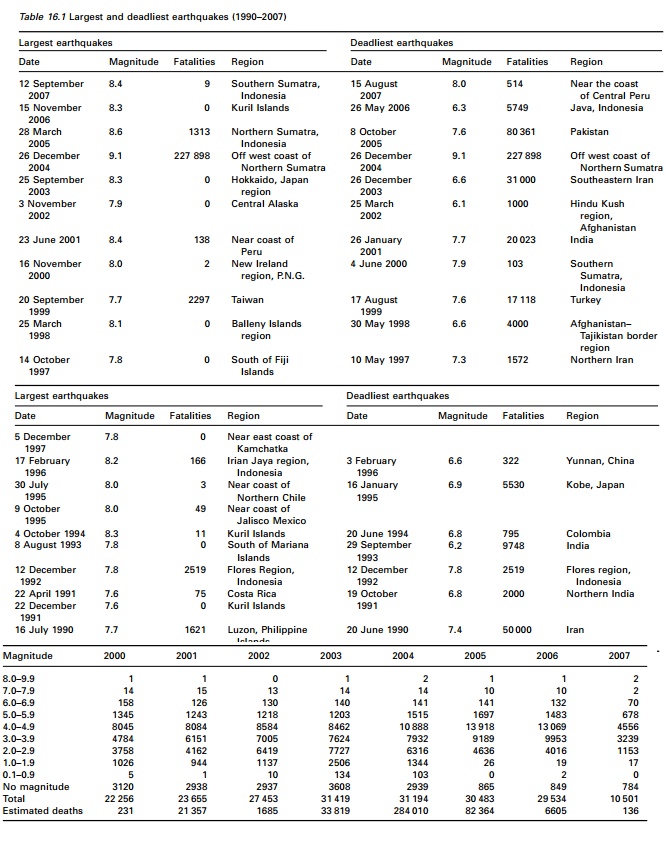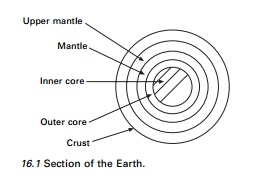Chapter: Civil : Structural dynamics of earthquake engineering
Earthquake
What is an
earthquake?
Simply stated,
earthquakes are vibrations of the Earth’s surface caused by waves emanating
from a source of disturbance inside the Earth. The nature of the disturbing
source can vary from a volcanic eruption to an underground explosion. An
earthquake is the sudden violent movement of the Earth’s surface from the
release of energy in the Earth’s crust.
There is some evidence that provides information
about the interior of the Earth. Volcanoes are within 200 km in depth; erosion
exposes rocks of 20â€' 25 km in depth, whereas existing mines are only a few
kilometres in depth. The Mohole Project was drilled by American scientists. To
minimize the drilling depth, the drilling was carried out in the east Pacific
Ocean because of its minimum oceanic crust; the depth drilled was up to 5.5 km.
The proposed depth was 10 km, but owing to high cost and difficulties the
project was abandoned. A similar project was carried out at Kola Peninsula by
Russians.

The results obtained
were important but not sufficient to determine the interior of the Earth since
its radius is 6378 km. The only source that provides reliable information about
the interior of the Earth is produced by seismic waves. Seismic waves travel at
different velocities since the Earth has many different compositions and
discontinuities. This throws light on the interior of the Earth. It consists of
three layers, viz. crust, mantle and core. The MohorovicÄŤic (moho)
discontinuity divides the crust and mantle, and the Gutenberg
discontinuity divides the mantle and core.
1 Crust
The crust is the
outermost part of the Earth. Crustal thickness in mountainous areas such as the
Alps and Himalaya is 70 km and in plains the thickness is 30 km. But below the
ocean the thickness is 5â€'8 km. The upper layer of the crust is called sial,
and the rock composition is granite; the bottom layer is called sima,
and the rock composition is basalt. Sial is absent in the ocean. A
discontinuity called the Conrad discontinuity separates sial and sima.
The velocity of the P wave in sial is 6.1 km/s and sima is 6.8 km/s. An
S wave travels at 3.4â€'4.4 km/s. Seismic waves attain greater velocity at 65 km,
indicating the Moho discontinuity. The specific gravity of the crust ranges
from 2.5 to 3.4. The volume of the crust is 2%.
2 Mantle
The volume of the
mantle is 82%. Velocities of P wave and S wave are 8.1 and 4.5 km/s
respectively. Peridotite is the rock type found in mantle. From 50 to 250 km
seismic wave velocity decreases, indicating a change in composition. Here P
wave velocity decreases from 8.1 to 7.8 km/s and S wave velocity decreases from
4.6 km/s. The temperature at this level is enough to make the rock mobile. This
layer is known as the asthenosphere. Above this is the lithosphere,
which is rigid and comprises crust and parts of upper mantle. Hence the
lithosphere moves above the asthenosphere and this movement is known as plate
tectonics. Deep focus earthquakes occur up to a depth of 700 km. In the
lower mantle, P wave velocity increases from 8.1 to 14 km/s. The temperature is
up to 3000 ď‚ o C. Pressure varies from 9 to 1400 kilobars.
3 Core
The volume of the core is 16%. The core
starts from 2900 km and reaches down to 6378 km (Fig. 16.1). Here P wave
velocity decreases from 14 to 8.1 km/s, indicating the change from solid state
to liquid state. S waves are not recorded because the outer core is in liquid
state. The outer core is

separated from the
inner core by the Gutenberg discontinuity. In the inner core P wave velocity
increases from 8.1 to 10.3 km/s. Specific gravity increases to 11.8 and
pressure increases to 3180 kbars. At the inner core P wave velocity increases
to 11.2 km/s. Pressure is up to 3300â€'3600 kbars and temperature is 6000 ď‚ o C.
Related Topics